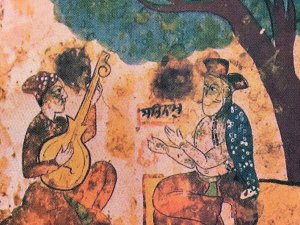|
|
|
Editor’s Note: This series is focused on exploring the core lessons for the soul as embodied in the Anand Sahib, written by the third Sikh Master, Guru Amar Das. There are three articles to introduce this Anand Sahib series and one on the First Pauree. To read those click below: Anand Sahib Intro
One of my favorite movies of all times is a movie called Luther, released in 2003. Luther recounts the life of Martin Luther, the famous Catholic monk who started the Christian Reformation movement. The movie insightfully depicts how the priests of the time spread superstition and fear among people, and basically distorted the teachings of the Gospel. Martin Luther felt outrage at the corruption he saw in the Catholic Church. In response to this, one of Luther's goals was to make the teachings of Jesus accessible to the common person in their own tongue. He believed that if people could read Jesus's words, themselves, they would not be so easily misled and exploited. Martin Luther translated the Bible into German. This simple act ignited tremendous violence between those who were outraged at being kept from the actual teachings of Christ and those who had an investment in protecting their status and power. Though Luther, himself, did not condone the violence, his writings contributed to class warfare within Germany between peasants and the aristocrats. In time, wars between Catholics and Protestants became a common occurrence in Europe. Since watching that movie, I sometimes joke to myself, "Who says that translating sacred teachings isn't an exciting and dangerous career?" It is dangerous, actually. This is because of something very simple and basic in human psychology. "God" is a word that human beings invented. "God" is a concept of our own making. "God" does not exist separate from human thought. It is a manifestation of human thought. It is the word we use to explain the Unknown and the Unseen. At its base, life exists in polarity. Where there is a known, there is an Unknown. When you have an answer to one question, it leads to new questions. Where you can see something, you also become aware of the limit of your vision. So where there is a seen, there is also an Unseen. That can create tremendous insecurity. Human beings are constantly walking around in the midst of what we do not know and what we cannot see. Every society, every culture defines the Unknown and the Unseen in particular ways. There is the ancient Egyptian pantheon: over 2,000 gods and goddesses, each with a specific domain. There are the names of "Allah" or "Yaweh" - very patriarchal and commanding Gods who reward those who love them and punish those who ignore them. The funny thing is, once those definitions get created, we forget that we human beings are the ones who created the definition to start with. We give our power away to those gods. We worship, follow and adore those gods. We take the definition for granted and live under those gods. And the people who become the representatives of those gods often achieve tremendous power and wealth on the earth. This means a class of people become very invested in making sure that the definition of "God" does not change. Yet, how we relate to and describe the Unseen and the Unknown does and must change over time. The earth is a continuously evolving system. Her evolution has always been towards complexity of consciousness. As human consciousness evolves, so our understanding of the Unseen and the Unknown must continue to redefine itself. Our idea of "God" needs to keep up with our own changes and growth. Those who say, "This is the final and last definition of God that will ever happen on the earth," do not really understand the game. So what does all of this have to do with the second pauree of the Anand Sahib? In the second pauree of the Anand Sahib, Guru Amar Das tells the mind to remain with Har always. If the mind stays with Har, a person will forget their pains and sorrows. They will feel themselves connected to everything, and all of their work will be completed for them. That's a pretty powerful statement. You won't suffer. You will feel connected to the entire fabric of reality. And everything will be done for you. All you have to do, mind, is to be with Har. Which begs the question. What is "Har"? In the practice of Kundalini Yoga, one of the mantras we chant is: "Har, Haray, Hari, Wahe Guru." Har, Haray, Hari are three sounds that explain the Creative Play. Har is the Divine essence, the seed, the Divine Reality in its purest potential. Haray is the unfolding of that seed. Its growth and maturity. Hari is the fruit, or the manifestation that comes from the seed. Wahe Guru. This process of unfolding is guided by the Guru, the Universal Teacher. When looking at Har in this pauree, it does not seem correct to say the mind needs to be with "God" or "the Lord." But rather - that the mind needs to see that Divine Seed within the self and within everything. Everything in creation has that Divine Essence at its core. As a poet, I also find the sound of the word very evocative, especially when repeated. Har…Har…Har…Har. It is what the sound of the beat of the heart might be to someone in a deep state of meditation. The seed of Divinity, or the Divine Essence, that lives within you and within all things: that is one way to define Har, and the way that I have chosen to understand this word in the second pauree of the Anand Sahib. But Har is not the only word for the Divine in this pauree. Suaamee is also used. And with the word Suaamee, comes the sense of the "Master." The Divine has a complex reality. While It exists within the creation, unfolding Itself through the play of time and space, there is also the "Master View" that watches and guides the entire process. When the mind tries to understand that Master view, it fails. The mind cannot fully comprehend the totality of the Unseen and the Unknown. But if the mind stays focused on Har, on the Divine Essence within the creation, then the Master can arrange everything. Once we stop trying to move the world with our minds, and we just remain in the presence of the Divine within the Creation, then the Master, who sees the total view, can move on our behalf. It's not logical. It's not rational. But that's the point. We come to a place of surrender where the Master moves, but the mind does not. Then life comes to a flow in which we feel connected with everything, but we do not command anything. We simply go along with it. The Divine is both present within the Creation, and unaffectedly watching and guiding it. This is the way I have come to understand the Unseen and the Unknown in the second pauree of the Anand Sahib. Other people may view these terms differently, and that is OK. Ultimately, we each have to experience for ourselves what our own relationship is to the Unseen and the Unknown. Every mind has to establish its own connection to that Vaster Reality which no one can ultimately describe. ਏ ਮਨ ਮੇਰਿਆ ਤੂ ਸਦਾ ਰਹੁ ਹਰਿ ਨਾਲੇ ॥ You! ਹਰਿ ਨਾਲਿ ਰਹੁ ਤੂ ਮੰਨ ਮੇਰੇ ਦੂਖ ਸਭਿ ਵਿਸਾਰਣਾ ॥ Be with the Essence of the Divine ਅੰਗੀਕਾਰੁ ੳਹੁ ਕਰੇ ਤੇਰਾ ਕਾਰਜ ਸਭਿ ਸਵਾਰਣਾ ॥ Feel the Divine Essence ਸਭਨਾ ਗਲਾ ਸਮਰਥੁ ਸੁਆਮੀ ਸੋ ਕਿਉ ਮਨਹੁ ਵਿਸਾਰੇ ॥ That powerful Master ਕਹੈ ਨਾਨਕੁ ਮੰਨ ਮੇਰੇ ਸਦਾ ਰਹੁ ਹਰਿ ਨਾਲੇ ॥2॥ Says Nanak,
|






